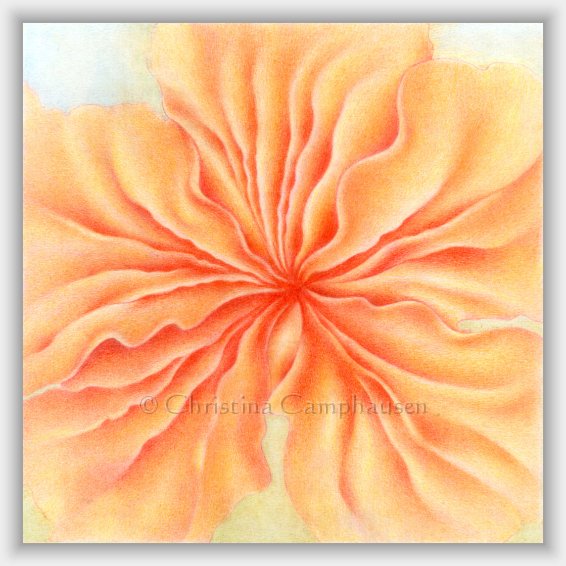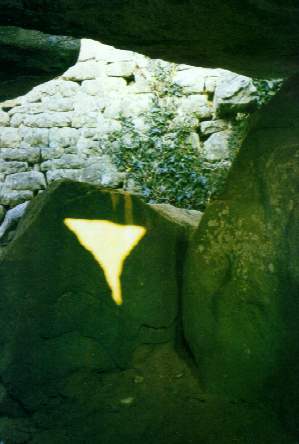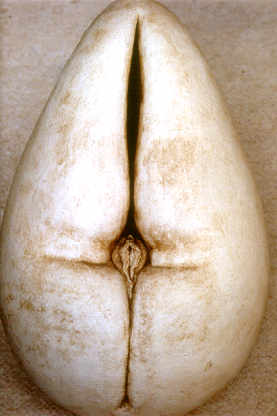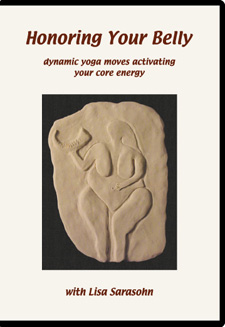What's in a Belly?
Archaic Knowing
by Lisa Sarasohn
author of The Woman's Belly Book
...encoded in ancient myths, images, and words of women's spiritual power. Archaic knowing, animated in our impulse to dance.
Myth: Our ancestors' stories celebrated the spiritual power concentrated in woman's belly. They personified the source energy that is centered within us as a mythic being—as a goddess, an aspect of the Sacred Feminine.
A Greek myth recorded in the seventh century BCE, for example, presents the belly goddess as Baubo.  Baubo is the belly-baring woman who plays the central role in Demeter's search for her daughter.
Baubo is the belly-baring woman who plays the central role in Demeter's search for her daughter.
In this myth, Demeter's separation from her daughter, Persephone, begins when Persephone's father Zeus helps his brother Hades to abduct the maiden. Hades steals Persephone into the underworld and rapes her.
Having lost her daughter, Demeter is devastated. She doesn't know where to look for Persephone, nor does she have the will to search. She loses hope. In her grief, she stops the crops from growing. The supply of food dwindles; starvation nears. The world is barren and drab.
Demeter arrives at Eleusis, utterly dispirited. Baubo steps up to her; she dances in front of Demeter and tells her bawdy jokes. Most accounts call her jokes "obscene." I suspect that they were the kind of rowdy jokes we tell each other with glee.
Now comes the pivotal moment: Baubo lifts her skirt. She bares her belly and flashes her vulva to Demeter.
And Demeter laughs. Mirth breaks through Demeter's despair; she soon resolves to resume her search for Persephone. Demeter's laughter gives her the guts to seek and ultimately reclaim her daughter. As she does so, abundant life returns to earth.
Lifting her skirt, baring her belly and revealing her vulva, Baubo is cunctipotent—the old word for demonstrating womanly, generative power. Baubo demonstrates to Demeter the center they share, returning the goddess to her own center of being. Demeter sees Baubo's belly, and she remembers who she is.
The belly-baring woman occurs not only in Greek legend but also in the Egyptian story of Isis and her lover Osiris. As Isis is mourning her lover's death, Baubo lifts her skirt to dispel the goddess's incapacitating grief. Like Baubo, women of ancient Egypt lifted their skirts and displayed their vulvas as a ritual gesture invoking the Sacred Feminine.
 In Japanese myth, Uzume plays a role similar to Baubo's in relation to the sun goddess Amaterasu. Frightened and angered by her brother's violent vandalism, Amaterasu retreats into a cave. In the goddess's absence, the rice does not grow; famine approaches.
In Japanese myth, Uzume plays a role similar to Baubo's in relation to the sun goddess Amaterasu. Frightened and angered by her brother's violent vandalism, Amaterasu retreats into a cave. In the goddess's absence, the rice does not grow; famine approaches.
Uzume gathers a crowd and dances a bawdy, skirt-lifting jig at the opening of Amaterasu's cave. The goddess hears the crowd's drumming and laughter and, curious, she steps out of her cave to investigate. Drawn back into the world by Uzume's joking and dancing, Amaterasu's presence regenerates the fields and the world.
Image: The vulva, the portal to the belly's power, is one of humankind's most ancient images. The first marks humans made to represent the Sacred Feminine are outlines of vulvas etched into the walls of caves in southern France, dating to 30,000 BCE.
The decorative arts of Eastern Europe witness that women have continued to image the vulva as gateway to the belly's energy of regeneration, literally embroidering on the designs that our earliest ancestors engraved in stone. Through the 19th century, one tradition of Eastern European embroidery depicted a female figure with legs spread, her vulva displayed as a diamond or triangle descending between her legs. The designs made by women of Eastern Europe illustrate motifs which have appeared as well for thousands of years in parts of Africa, Asia, the Pacific islands, and North and South America.
In England, Ireland, and Wales in the late Middle Ages, artisans carved Sheila-Na-Gigs—figures of squatting women holding their vulvas open wide—into the stone arches framing church windows and entryways. Similar figures occur both in the temples of India and in cathedrals throughout Europe. They define the entrance to and protect sacred space; by analogy, their vulvas are the doorway, their bellies are the sanctuary within.
The Sheila-Na-Gigs bear traces of Baubo, the belly goddess, and tell what's become of her.
Most of the Sheila-Na-Gigs have been chiseled off, defaced, buried or destroyed. Likewise, Baubo and woman's belly have been desecrated.
Word: The "gig" within "Sheila-Na-Gig" relates to the English gig and jig, and to the
French gigue. The evolution of the word and its relations is instructive; the word's evolution parallels the patriarchal process of devaluing women and de-meaning the spiritual power of our sexual energy.
 The source of "gig" may be the title of priestesses in ancient Sumeria; women serving within the temple were named nu-gig, meaning "the pure," "the spotless." A more recent root is the Middle English gigg, meaning both something that whirls—a spinning top, a whirligig—and a giddy girl. In its archaic usage, "gig" means a joke or whim, also a person of odd or grotesque appearance.
The source of "gig" may be the title of priestesses in ancient Sumeria; women serving within the temple were named nu-gig, meaning "the pure," "the spotless." A more recent root is the Middle English gigg, meaning both something that whirls—a spinning top, a whirligig—and a giddy girl. In its archaic usage, "gig" means a joke or whim, also a person of odd or grotesque appearance.
Related to "gig," the words giglet and giglot name a silly, frivolous girl and also a lascivious, wanton woman. Gigolette means both "a girl who frequents public dances" and "prostitute," equating the two. The French "gigue" refers to the dancing that, before the imposition of Christianity, was sexually expressive, wildly unrestrained.
Gigue's somewhat tamer English relation, jig, is a lively dance in triple rhythm, an up-and-down figure marking the vertical axis that remains steady within a spin. A "jig" is also a joking song, and the comic relief that occurs in the middle or at the end of a play.
The echoes embedded in "gig" speak of women attuned to the Divine life force.
They speak of women dancing, spinning in circles, ecstatically, erotically, their sexual energy unleashed, laughing uproariously. Their dancing, their comedy, is akin to Baubo's bawdy dancing and joking before Demeter.
As patriarchy has proceeded to devalue women and de-mean women's erotic life force, "gig" has become a label for a child's toy, an ugly old hag, a whore, a bimbo. And as patriarchy has proceeded to eliminate women's ways of power—most blatantly by executing nearly nine million wisdom-keepers in Europe alone in the 15th through 17th centuries—many traditions of women's belly-honoring, belly-energizing dance have been lost and forgotten.
In current usage, "gig" has taken on the notion of event, or action in the world—as in "I have a gig tonight." The word also means "purpose"; for example, the minister of the church I attend often asks the congregation "What's your gig?" Now our gig is to look to other continents—to the Middle East, Asia, India, Africa-for the gut-stirring, sensual, earthy dance forms we crave.
When we dance, when we whirl, when we laugh with the energy that upwells from our bellies, we are enacting the impulse that is embedded in our bones, our muscles, our breath—an impulse as ancient as human consciousness. We are spinning in time, out of time, with Baubo, the belly goddess.
© Lisa Sarasohn 2010

The Woman's Belly Book:
Finding Your True Center for More Energy, Confidence, and Pleasure

by Lisa Sarasohn ~~
Your body's center, your belly, is home to your core life force. It's the site of your soul power, the source of your passion and creativity, your intuition and sense of purpose, your courage and confidence. The Woman's Belly Book presents inspiring information, playful activities, and power-centering exercises to kindle the life energy concentrated in your body's core. Are you ready? Honor your belly and activate your Source Energy. Enjoy!
Order The Woman's Belly Book in our Bookshop
 Honoring
Your Belly DVD
Honoring
Your Belly DVD
by Lisa
Sarasohn
This fun and instructional video with Lisa Sarasohn is much more than a set of conventional stomach-crunching exercises. This dynamic sequence of belly-energizing moves draws from the wisdom of yoga and other healing arts.
This 45-minute DVD video teaches you a dynamic sequence of belly-energizing yoga moves that develop and direct the Source Energy concentrated in your body's center.
Price: $29.95
Order Honoring
Your Belly DVD in our Bookshop

Online Course by Lisa Sarasohn

Initiation 2012:
Awakening Your Sacred Center, Part I
Mentor: Lisa Sarasohn
The year 2012 heralds a revolution in human consciousness. The signs suggest that the Sacred Feminine will be informing, and reorganizing, every aspect of human experience. As we embody the Sacred Feminine, we’ll be equipped to participate in — and shape — this evolution of human awareness with wisdom and grace.
This course is the first part of an ongoing process through which you embody the Sacred Feminine by energizing your body’s center with breath, image, story, and movement.
As a first step, this course focuses on befriending your body’s center and learning yoga-based movement and breathing exercises that will form the core of your practice. (Even if developing a movement practice isn’t for you at this time, you’ll still find a process that engages and rewards your participation.)
Sign up for Awakening Your Sacred Center, Part I
 About the Mentor, Lisa Sarasohn
About the Mentor, Lisa Sarasohn
This workshop flows from my quest for the Sacred Feminine blended with my experience practicing and teaching yoga.
I’ve been a Kripalu Yoga instructor since 1979. I’ve also trained as a yoga and bodywork therapist.
From 1981 to 1988, I served on staff at Kripalu Center for Yoga & Health in Lenox, MA. During this time, I led yoga classes for thousands of guests, conducted a practice in bodywork th erapy, designed workshops on many aspects of holistic health, and trained yoga teachers and bodyworkers.
In the course of my continuing yoga studies, I learned how cultures around the world have valued the body’s center as sacred. Delving deeper into this subject revealed connections between the body’s center and qualities of the soul, the extent of women’s power in family and society, and the degree of a culture’s reverence for Sacred Feminine.










